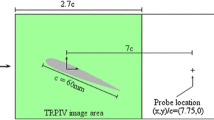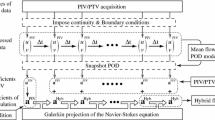Abstract
In this paper, we shall investigate sequential data assimilation techniques to improve the stability of reduced-order models for fluid flows. The reduced-order model used relies on a Galerkin projection of Navier–Stokes equations on proper orthogonal decomposition (POD) basis vectors estimated from snapshots of the flow fields obtained with time-resolved particle image velocimetry (TR-PIV) measurements. The coefficients of the dynamical system are given through a least-squares regression technique applied to the experimental data and lead to a low-order model which is known to diverge, or damp, rapidly in time if left uncontrolled. In this context, a sequential data assimilation method based on a Bayesian approach is proposed. In this formalism, reduced-order models (ROMs) are modeled with discrete time from the hidden Markov processes. Given the whole trajectories of the POD temporal modes, the state of ROM coefficients initially provided by noisy PIV measurements are re-estimated from a Kalman filtering of the sequential data. Results are obtained for the flow around a NACA0012 airfoil at Reynolds numbers of 1000 and 2000 and angles of attack of \(10^{\circ },15^{\circ },20^{\circ }\) and \(30^{\circ }\).




















Similar content being viewed by others
References
Anderson MJ (2001) Permutation tests for univariate or multivariate analysis of variance and regression. Can J Fish Aquat Sci 58(3):626–639
Andrews A (1968) A square root formulation of the kalman covariance equations. AIAA J 6:1165–1166
Aubry N (1991) On the hidden beauty of the proper orthogonal decompositon. Theoret Comput Fluid Dyn 2:339–352
Aubry N, Holmes P, Lumley J, Stone E (1988) The dynamics of coherent structures in the wall region of a turbulent boundary layer. J Fluid Mech 192:125–143
Bergmann M, Cordier L (2008) Optimal control of the cylinder wake in the laminar regime by trust region methods and pod reduced-order models. J Comp Phys 227:7813–7840
Bergmann M, Cordier L, Brancher J (2005) Optimal rotary control of the cylinder wake using pod reduced order model. Phys Fluids 3:1–21
Berkooz G, Holmes P, Lumley J (1993) The proper orthogonal decomposition in the analysis of turbulent flows. Ann Rev Fluid Mech 25:539–575
Bishop C, Etherton B, Majumdar S (2001) Adaptive sampling with the ensemble transform kalman filter. Part I: theoretical aspects. Mon Wea Rev 129(3):420–436
Buffoni M, Camarri S, Iollo A, Salvetti M (2006) Low-dimensional modelling of a confined three dimensional wake flow. J Fluid Mech 569:141–150
Burgers G, Van Leeuwen P, Evensen G (1998) Analysis scheme in the ensemble Kalman filter. Mon Wea Rev 126:1719–1724
Cao Y, Zhu J, Navon I, Luo Z (2007) A reduced order approach to four-dimensional variational data assimilation using proper orthogonal decomposition. Int J Numer Methods Fluids 53(10):1571–1583
Cazemier W, Verstappen R, Veldman A (1998) Proper orthogonal decomposition and low-dimensional models for driven cavity flows. Phys Fluids 10(7):1685–1699
Cordier L, El Majd BA, Favier J (2010) Calibration of POD reduced-order models using Tikhonov regularization. Int J Numer Meth Fluids 63:269–296
Couplet M, Badevant C, Sagaut P (2005) Calibrated reduced-order pod-galerkin systemfor fluid flow modelling. J Comput Phys 207(1):192–220
Deane A, Kevrekidis I, Karniadakis G, Orszag S (1991) Low-dimensional models for complex geometry flows: application to grooved channels and circular cylinders. Phys Fluids A 3(10):2337–2354
Delville J, Ukeiley L, Cordier L, Bonnet J, Glauser M (2001) Examination of large-scale structures in a turbulent plane mixing layer. Part 1. Proper orthogonal decomposition. J Fluid Mech 391:91–122
Evensen E (2004) Sampling strategies and square root analysis schemes for the EnKF. Ocean Dyn 54:539–560
Evensen G (1994) Sequential data assimilation with nonlinear quasi-geostrophic model using Monte Carlo methods to forecast error statistics. J Geophys Res 99(C5):10143–10162
Evensen G (2003) Ensemble Kalman filter: theoretical formulation and practical implementations. Ocean Dyn 53(4):343–367
Evensen G (2006) Data assimilation the ensemble Kalman filter. Springer, Berlin
Fang F, Pain C, Navon I, Piggot M, GJ G, Goddard A (2009) Reduced order modelling of an adaptative mesh ocean model. Int J Numer Methods Fluids 59(8):827–851
Galletti B, Bruneau C, Zannetti L, Iollo A (2004) Low-order modelling of laminar flow regimes past a confined square cylinder. J Fluid Mech 503:161–170
Galletti B, Bottaro A, Bruneau C, Iollo A (2005) Accurate model reduction of transient flows. RR INRIA 5676:141–148
Gelb A (1974) Applied optimal estimation. MIT Press, Cambridge
Holmes P, Lumley JL, Berkooz G (1996) Turbulence, coherent structures, dynamical systems and symmetry. Cambridge Monographs on Mechanics. Cambridge University Press, New York
Houtekamer P, Mitchell H, Pellerin G, Buehner M, Charron M, L S, B H (2005) Athmospheric data assimilation with an ensemble kalman filter: results with real observations. Mon Wea Rev 133:604–620
Huang R, Wu J, Jeng J, Chen R (2001) Surface flow and vortex shedding of an impulsively started wing. J Fluid Mech 441:265–292
Kalman R, Bucy R (1961) New results in linear filtering and prediction theory. J Basic Eng Trans ASME Ser D 83(3):95–108
Karamanos G, Karniadakis G (2000) A spectral vanishing viscosity method for large eddy simulations. J Comput Phys 163(1):22–50
Le Dimet FX, Talagrand O (1986) Variational algorithm for analysis and assimilation of meteorological observations: theoretical aspects. Tellus 38(A):97–110
Le Gland F (2009) Introduction au filtrage en temps discret—filtre de kalman, filtrage particulaire, modèles de markov cachés. Ecole Nationale Supérieure de Techniques Avancées
Lumley J (1967) The structures of inhomogeneous turbulent flow. In: Yaglom AM, Tatarski VI (eds) Atmospheric turbulence and radioWave propagation. Nauka, Moscow Edition, pp 166–178
McKean H (1969) Propagation of chaos for a class of non-linear parabolic equations. Lectures series in differential equations, vol 2, volume 19 of Van Nostrand Mathematical Studies. Vans Nostrand Reinhold, NewYork, pp 177–194
Noack B, Afanasiev K, Morzynski M, Tadmor G, Thiele F (2003) A hierarchy of low-dimensional models for the transient and post-transient cylinder wake. J Fluid Mech 497:335–363
Noack B, Papas P, Monkewitz P (2005) The need for a pressure-term representation in empirical Galerkin models of incompressible shear flows. J Fluid Mech 523:339–365
Perret L, Collin E, Delville J (2006) Polynomial identification of pod based low-order dynamical system. J Turbul 7(17):1–15
Pham D (2001) Stochastic methods for sequential data assimilation in strongly nonlinear systems. Mon Wea Rev 129:1194–1207
Pham D, Verron J, Gouideau L (1998) Filtres de kalman singuliers évolutifs pour l’assimilation de données en océanographie. CR Acad Sci Paris 326:255–260
Podvin B, Lumley J (1998) A low-dimensional approach for the minimal flow unit. J Fluid Mech 362:121–151
Rempfer D (2000) On low dimensional galerkin models for fluid flows. Theor Comput Fluid Dyn 14(2):75–88
Sirovitch L (1987) Turbulence and the dynamics of coherent structures. Part 1: coherent structures. Quart Appl Math XLV(3):561–574
Tippett M, Anderson J, Bishop C, Hamill T, Whitaker J (2003) Ensemble square root filters. Mon Wea Rev 31:1485–1490
Whitaker J, Hamil T (2002) Ensemble data assimilation without perturbed observations. Mon Wea Rev 130:913–1924
Acknowledgments
This work has supported by the EU-project: Advanced Flow Diagnostics for Aeronautical Research, project no. 265695.
Author information
Authors and Affiliations
Corresponding author
Rights and permissions
About this article
Cite this article
Romain, L., Chatellier, L. & David, L. Bayesian inference applied to spatio-temporal reconstruction of flows around a NACA0012 airfoil. Exp Fluids 55, 1699 (2014). https://doi.org/10.1007/s00348-014-1699-3
Received:
Revised:
Accepted:
Published:
DOI: https://doi.org/10.1007/s00348-014-1699-3




